
FLOATING ON THE FIERY POOL: The Maya represented the “world turtle” on this lidded box |
| “Fiery Pool: The Maya And The Mythic Sea” and “The Kennedys | Portrait Of A Family: Photographs By Richard Avedon” | Peabody Essex Museum, East India Square, Salem | Through July 18 |
Some weeks back, I got to listen to Brown University archæology professor Stephen Houston pronounce the throaty, staccato sounds of Maya hieroglyphs carved across a six-foot-wide limestone panel — part of the Peabody Essex Museum’s “Fiery Pool: The Maya and the Mythic Sea.” The panel — which is thought to date to 799 AD, and to have decorated a Maya royal tomb — eventually toppled face down onto the ground, and that act preserved the 160 delicately carved, cartoony-cute glyphs of birds, a turtle shell, footprints, and beheaded captives. Houston read of a king taking his throne in 656 AD and then making a ritual pilgrimage to the coast — “inside the pool, the three-turtle island, within/inside the heart of the turtle.” It was a tale, he said, of a king going to the sea, to connect with its power, and affirm his authority.“Fiery Pool,” which Houston organized with Peabody Essex maritime curator Daniel Finamore, is billed as “an entirely new way of viewing the art of a great civilization” and “a radical new conception of the Maya worldview.” Building on recent advances in deciphering Maya iconography and hieroglyphs (“It was not until the late 1980s that a glyph for the sea was identified”), they argue that the sea had a hitherto unrecognized influence on Maya cosmology, trade, and power. The scholarship is impressive. But the more than 90 artifacts — nearly half never before seen in the US — are mostly small, detailed works that require close attention if you’re to feel their force.
The show opens with an imposing, seven-foot-tall limestone figure of the rain and storm god Chahk, circa 800-900 AD. He has simple, doll-like features — wide square eyes, his mouth open in a shout — and an ax (the blade is missing) with which he sparks lightning storms. The Maya saw water as a living force. The rising sun was depicted with shark-like features. Cosmic crocodiles exhaled rain clouds, which nourished crops. Clouds were also the essence of dead ancestors rising from the sea. Says Houston, “These are natural cycles that are imbued with meaning and being and personality.”
Maya civilization arose around 2000 BC and reached its height beginning around 200 AD in the Yucatán Peninsula, which spans today’s Mexico, Guatemala, Belize, and Honduras. Surrounded by water, the Maya envisioned the world as a turtle floating upon a “fiery pool” — namely, the waters that lit up as the sun rose in the Caribbean and set in the Gulf of Mexico.
These people are remembered for pyramid building, human sacrifice, the Popl Vuh creation tale, and astronomy that produced an extremely accurate calendar — you know, the one predicting the world will end in 2012. (Scholars actually believe that 2012 was just the year the Maya were due to get a new calendar.) It all fell to pieces around 900, the causes perhaps chronic war and drought (water again). Tropical forests swallowed the great pyramids, and the Maya’s language was forgotten.